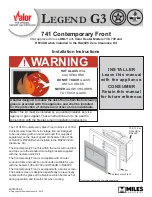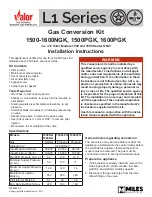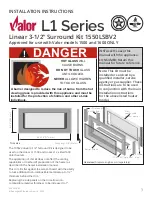
I n s t a l l a t i o n I n s t r u c t i o n s
5
4 Preparation and installation
instructions
4.1
Gas connection
The gas connection must comply with the applicable local
standards.
We advise using a Ø 15mm gas connection directly from the gas
meter to the appliance, with a shut-off valve in the proximity of the
appliance, which must always be freely accessible.
Position the gas connection so that it is easily accessible at all
times for service, and that the burner unit can be disassembled.
4.2
Electrical connection
The power supply must comply with the applicable local standards.
A wall socket 230VAC/50Hz must be installed near the fire.
For power supply make use of the included plug adapter.
See fig 1.8 for the wiring diagram of this connection and the LED
Symbio module.
A = LED Symbio module
B = receiver/control unit
C = plug adapter
4.3
Preparing the fire
•
Remove the fire from its packaging.
•
To do this unscrew the nut and bolt in the bottom plate
•
Remove frame and glass (see Chapter 5) and take the
packaged parts from the fire.
•
Store frame and glass in a safe place.
•
The included wall bracket (fig 1.9) is only for use with the
optional extension modules.
See chapter 19 until 21 for the instructions of this extension
modules.
•
Prepare the gas connection on the regulator
•
When necessary the upper and the lower panels can be
removed.
Therefore loosen the 2 bolts on the inside left and right, lift
the panel a little. The panel can be moved forward now.
(fig 1.6 B)
The middle panel is loose, for access to the gas control.
4.4
Positioning the fire
•
Take the installation requirements into account
(see Chapter 3).
•
The fire can be levelled with the 4 adjustable feet in the
bottom plate ( fig 1.6 C) and by use of a hex wrench #5.
4.5
Installing the Flue materials
•
For fitting the flue pipe on the fire the top plates can be
removed. (fig 1.7)
•
When penetrating a wall or ceiling the opening must be at
least 5mm larger than the diameter of the flue pipe.
•
Horizontal sections should be installed with a slope towards
the fire (3 degrees).
•
Build the system upwards from the fire. If this is not possible
you can make use of an extendable adapter section.
•
For truing up the exhaust system use the ½ meter pipe,
which can be shortened and ensure that the inner pipe is
always 2cm longer than the outer pipe.
•
Any parts which can be shortened must be secured with a
self-tapping screw
•
Wall and roof terminals can also be cut to length.
•
Do not insulate but ventilate any built-in flue pipes. (approx.
100cm2).
•
When using the optional extension modules see Chapter
19 until 21 for the installation instruction of this modules in
combination with the flue pipes.
5 Removing the glass
•
Remove the window frame, push up and pull the bottom
forward. (Fig 1.1 and 1.2)
•
Remove all glass clamps and remove the glass.
( Fig 1.3 and 1.4)
•
Placing the glass goes in reverse order
> Note: Remove the fingerprints from the glass these will
burn in and cannot be removed after the fire is used
6 Placing the decorative material
It is not allowed to add different or more materials to the combusti-
on chamber.
Always keep the pilot burner free from decorative material!
6.1
Placing the imitation logs
•
Place the glass panel (Fig 2.0 F) on the bottom in the gaps
left and right.
•
Spread the glass fragments over the glass panel (one layer)
and cover these with part of the vermiculite supplied (the
amount of vermiculite affects the intensity of the glow effect
and can be done according to your own discretion)
•
Place the imitation logs. Make sure that the logs are properly
connected to the tube burners and rest on the bottom of the
fire.
If necessary remove glass fragments and/or vermiculite
underneath the burners. (see fig. 2.1 or the supplied
instruction card).
•
Spread the rest of the vermiculite and the chips over the
bottom of the burning chamber. Ensure that the air openings
are not covered.
Start the fire as described in the user manual. Check the appearan-
ce of the flames and for burning against the vermiculite.
7 Checking the installation
7.1
Checking the ignition of the pilot burner and main
burner
Light the fire as described in the user manual.
•
Check that the pilot flame is not covered by chips and/or an
imitation log.
•
Check the ignition of the main burner on full and low setting.
(ignition must be smooth and quiet).
7.2
Checking for gas leaks
Use a gas leak finder or spray to check all connections and pipes
for gas leakage.
Содержание Blokhus 40011609-1545
Страница 1: ...Blokhus 40011609 1545 Blokhus ENG ...
Страница 2: ...I n s t a l l a t i o n I n s t r u c t i o n s 2 DE 1 6 1 4 1 7 1 5 1 1 1 3 1 2 A C B ...
Страница 3: ...I n s t a l l a t i o n I n s t r u c t i o n s 3 A B C AUX 2 0 1 8 1 9 2 1 2 2 F ...
Страница 18: ...18 Instruction extension Module s 1 8 I n s t a l l a t i o n I n s t r u c t i o n s ...
Страница 21: ...2 1 I n s t a l l a t i o n I n s t r u c t i o n s 20 3 Wall bracket ...
Страница 22: ...2 2 I n s t a l l a t i o n I n s t r u c t i o n s ...
Страница 23: ...2 3 I n s t a l l a t i o n I n s t r u c t i o n s ...
Страница 24: ...2 4 www faber nl info faber nl Saturnus 8 NL 8448 CC Heerenveen Postbus 219 NL 8440 AE Heerenveen Dealerinfo ...






































